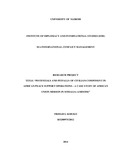| dc.description.abstract | Since the establishment of the African Union in 2002, the Commission has taken
an active role in addressing protracted conflicts in the continent as well as ventured in
conflict zones that other multilateral organisations such as the United Nations would not
be willing to deploy peace operations. The role of the civilian component in peace
operations has become a major contributing success factor towards achieving the mission
mandate and in particular addressing root causes of conflict. To this end, this study
examined the role of the civilian component in AU led PSOs using the AMISOM case
study. The study scrutinized previous peace operations in Somalia undertaken by UN and
regional organisations and sought to extract the lessons learnt from those operations and
investigate whether they have been incorporated in the AMISOM operation. In order to
extract the potentials and pitfalls of the civilian component in AU PSOs, the study
conducted an in-depth analysis of the AMISOM civilian component and interrogated the
mission mandate, mission composition and considered other players such as UN and
international organisations all aiming towards stabilising Somalia.
Based on the nature of the study, a large part of the research findings was derived
from systematic literature review of AU/ UN official reports, scholarly contributions on
AU PSOs and other literal works published on the subject matter. Further, the study was
complimented by focused group discussions of AMISOM employees attending training at
International Peace Support Training Centre and interviews with key persons with
expertise on the subject matter from academic and policy circles. The research
methodology was also complimented by questionnaire responses from Somali population.
The study relied on constructivism theory of international relations complimented
by structural functionalism in placing the role of the civilian component in AU peace
operations. The study established that even though the role of the civilian component is
well captured on the AU PSOs doctrine reflected by many key policy documents, the
actual implementation on the ground is dismal. AU PSOs are military focused thereby
concentrating on the security paradigm and negating key components of development,
humanitarian, political and social aspects which are of absolute importance in attaining
sustainable peace. Moreover, the study revealed that some key functions which the
civilians’ component can play a significant role in enhancing sustainable peace in
Somalia such as Rule of Law were missing from the mission structure. Finally, the study
exposed coordination and overlap of functions between UNSOM and AMISOM civilian
components and called for coherence and harmonisation of processes to avoid duplication
of effort and ensure that the few resources availed to Somalia are utilised in a result
oriented manner.
Based on these findings the study has made some key recommendations, starting
with the actualisation of the policy guidelines and strengthening of the civilian capacity
through systemic organisational learning processes and ensuring the rostering of the
civilian capacities is done in a systematic and coherent manner between the AU, RECs
and member states. The study also recommended that AU and RECs involved in
identification of the civilian capacities should employ a deliberate effort to include
qualified non-state actors. The cooperation experienced in international peace and
security can be fostered by AU through regular exchanges of best practises in PSOs
especially concerning the dynamics and recruitment of the civilians in peace operations. | en_US |

